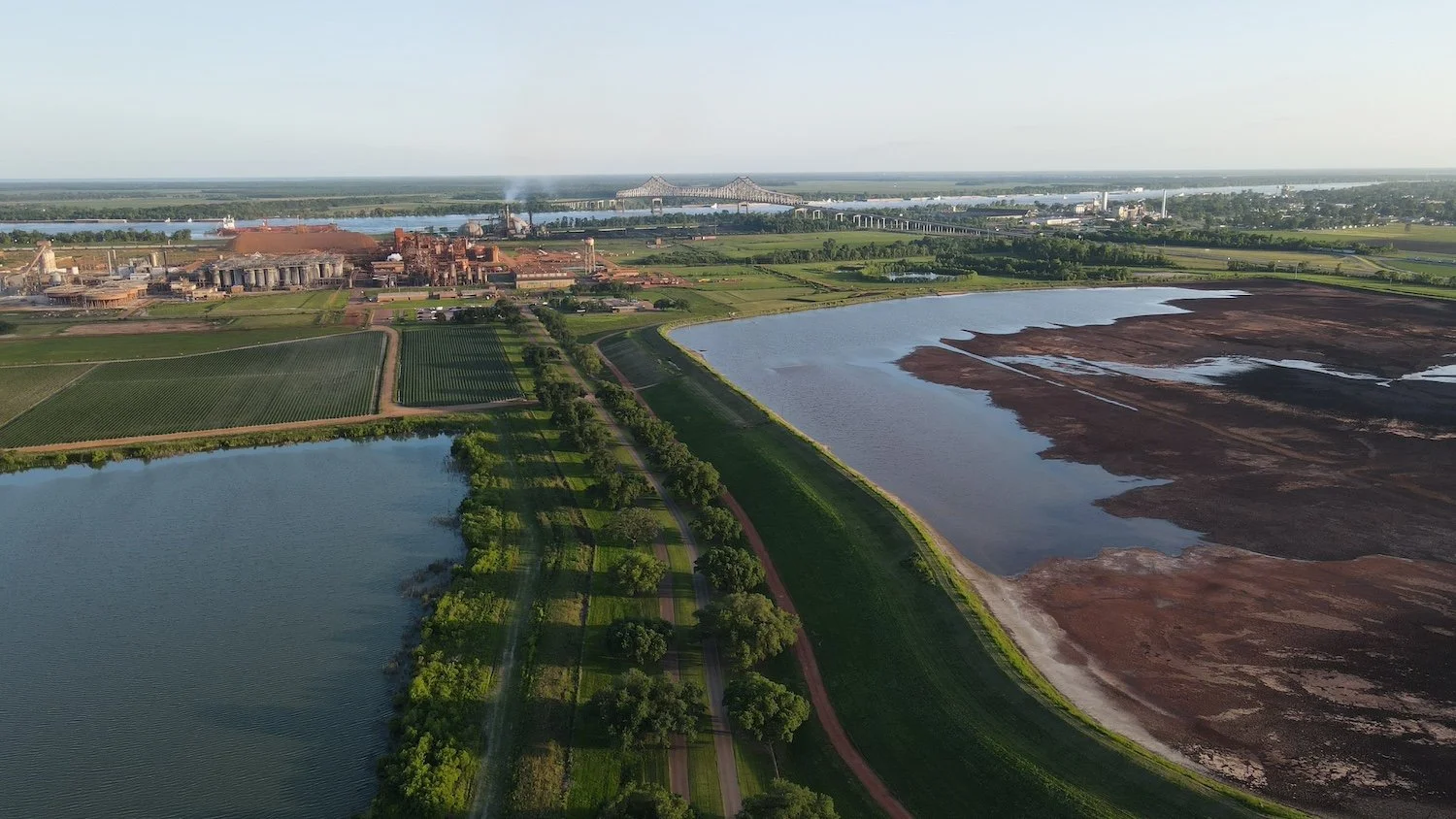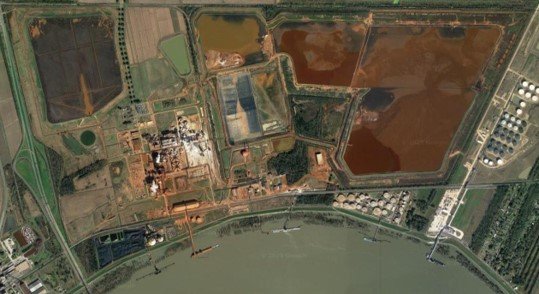
A partial view of the last operating refinery in the US in Gramercy, LA.

There is no good news for the environment or surrounding aluminum communities.
The same process from the late 1800’s - Bayer Hall–Héroult process is still being used today around the world. Even after over 100 years of marginal improvements, aluminum still requires massive amounts of uninterrupted electricity, emits over 3% of industrial emissions globally, and leaves behind horrific amounts of toxic caustic permanent waste debilitating local communities.
The lower Mississippi between New Orleans and Baton Rouge is polluted with abandoned alumina refineries. Millions of tons of “red mud lakes” more accurately described as permanent caustic, toxic waste have created one of the most polluted areas in the world. Only one alumina refinery remains operational in the United States in Gramercy, LA. A new refinery could never be permitted again in the US, but this burden cannot be left to emerging nations with bauxite reserves.
A fundamentally new process that uses significantly less energy and doesn’t pollute the atmosphere or environment is needed. No significant research is happening in the aluminum industry. The Industry’s only solution is “green” energy. The following articles illustrate the magnitude of the problems that cannot be addressed with “green” energy.
Aluminum Technologies alone has invented an affordable, clean process from mine to metal.

The ignored pollution from making aluminum
-

Levee breaks at Atalco plant sent arsenic, cadmium and other poisonous metals into a Lake Maurepas swamp
Red Alert: A Louisiana refinery spilled toxic waste into the community and knew about it for months.
A soil sample taken from the same ditch contained mercury, beryllium, cadmium, and chromium— all at concentrations above the average background levels found in U.S. soils. The cadmium was nearly 400% higher, and the chromium was 900% higher than LDEQ’s standard limits for soil. In its hexavalent form, which is created through industrial processes, chromium is the most toxic non-radioactive element on earth and is about three times more poisonous than arsenic, according to EPA toxicity factors.
-

Biden's DOE Invests $500 million in old polutting technology, reduces emissions but increases toxic caustic waste.
The US is funding a new “FOAK” smelter with the same old Hall-Heroult technology. The reduction in emissions will mostly come from a “green” energy source that has yet to be determined or announced. Meanwhile, the last remaining refinery in the US, Gramercy, Louisiana, will supply alumina to the new smelter, leaving behind millions of tons of toxic caustic waste. It’s no wonder Louisiana is one of the world's most polluted regions.
-

Tulane, LEAN: Noranda should be treated as major source, be forced to limit mercury emissionsm
..But attorneys with the Tulane Environmental Law Clinic and experts sought by the Louisiana Environmental Action Network and other environmental groups are questioning the longstanding characterization of Noranda as a minor source as the new owners ask for permission to send up to 1,500 pounds of mercury per year into the air and become far and away Louisiana's top air emitter of mercury.
With the permit, the plant would also rival the top three facilities for mercury air pollution in the nation between 2013 and 2015, according to the U.S. Environmental Protection Agency's Toxics Release Inventory database. Mercury is a heavy metal found to be harmful, even in tiny amounts, to the environment and people, especially children and fetuses.
-

Ford's Electric Pickup is Built From Metal that's Damaging the Amazon
A class-action lawsuit on behalf of 11,000 residents of neighborhoods surrounding that refinery, Hydro Alunorte, names owner Norsk Hydro ASA of Norway as responsible for polluting their rivers and streams. The suit cites toxic mud containing elevated levels of aluminum and other heavy metals, which are byproducts of refining bauxite into alumina, the white powder that becomes aluminum. Alunorte’s actions, it alleges, have caused health problems such as cancer, hair loss, neurological dysfunction, birth defects and increased mortality.
-

Why Chinese Aluminium Producers Emit So Much of Some of the World's Most Damaging Greenhouse Gases
More than half of the aluminum in the world is produced in China, but it is responsible for 81 percent of the industry’s emissions of PFCs. 7% of China’s electricity is used to produce primary aluminum. 100% of the energy use is generated by coal burning power plants.
-
The Fight against Mining in Jamica's Rainforest
The Maroons, descendants of Indigenous people on the island nation, are blocking the government’s plan to move bauxite mining to their ancestral land.
-

Red, toxic mud and dust have long bothered this Louisiana community
For years, toxic and slightly radioactive red mud and dust from the waste ponds of a shuttered alumina plant have bothered neighborhoods…
-

Environmental and Citizens Groups Object to Issuance of Mercury Air Emissions Permit for Noranda Alumina Plant
Louisiana Environmental Action Network, Sierra Club Delta Chapter, Gulf Restoration Network, Louisiana Audubon Council and others on June 8, 2017 filed strong objection to the proposed issuance of a Mercury Air Emissions Permit for the Noranda alumina plant in St. James Parish near Gramercy. The Plant produces alumina from bauxite, an ore that contains mercury. The plant has been emitting mercury to the air, probably since production started in 1959 when it was owned by Kaiser, but has never been required by Louisiana Department of Environmental Quality to obtain a permit.
-

Why is the sky red like 'a sunset' in the early afternoon? Residents blame chronic dust from plant
River Ridge, Pelican Crossing and other suburban Ascension neighborhoods in the Burnside area south of Interstate 10 are close to a roughly 500-acre waste pile, or "red mud lakes," for a shuttered processing plant along the nearby Mississippi River.
For years LAlumina has generated complaints from residents and dings from state inspectors, including compliance orders, over dried dust from the red mud lakes north of La. 22.
Contained with levees, the sometimes slushy red mud is filled with the spent tailings from bauxite ore processing and is laced with trace amounts of heavy metals and radioactive particles.
-

The Aluminum Paradox
Vital for clean energy, but also a major source of greenhouse gases, and air and water pollution. 9/27/2023 Environmental Integrity Project




